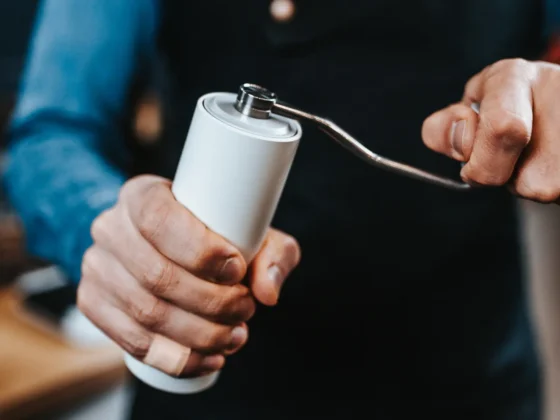Let’s face it freshly roasted coffee is heavenly. I think it’s true to say that we’d all prefer a fresh bag of roasted coffee over anything that is sold at the grocery store, right? But did you know that if the coffee is too fresh it can be just as bad as stale coffee? This is true, extremely fresh coffee that has just been roasted goes through a “Degassing” stage. So if you’re just getting into coffee roasting or love brewing coffee, stick around as I will explain the process of degassing roasted coffee beans, and how it affects your coffee bean.
What Is Coffee Degassing?
During the process of coffee roasting, carbon dioxide along with other gasses form within the coffee bean. Majority of these gases are released within the first 24 hours after the roasting process and continue to emit for the next 14 days.

Attempting to brew freshly roasted coffee that hasn’t properly degassed, can result in a bubbly brew with air pockets that can obstruct the water from making contact with the coffee, leaving you with an uneven brew that tastes sour. This can negatively affect the quality of your brew’s flavor and aroma, so it’s highly advised that you wait out the appropriate degassing duration before you decide to brew.
Why Do My Coffee Beans Release Gas?
When coffee beans get roasted, they go through many different chemical reactions, the beans begin to darken and the heat starts to break down the complex carbohydrates. Smaller molecules are created and form vapor and carbon dioxide. When the beans build up enough gases, the pressure forces the bean’s cell wall to break, this is known as the “first crack”. Due to the release of energy and sugar transformation in the roasting process, carbon dioxide is most evident in the last stages of roasting.
How Long Am I Degassing Roasted Coffee Beans For?
The presence of carbon dioxide in our coffee beans may sound bad, but did you know that it has a positive effect on our coffee? Being an indicator of freshness, the gas increases the coffee’s shelf life. It plays an important part in the extraction process of the coffee and affects crema formation. (1) To determine how long you need to degas your beans for you need to consider some key factors, like the type of coffee roast, the size of the bean, and the processing method.
As I mentioned above, the majority of the bean’s gasses are released within the first 24 hours after roasting and continue to releases gas for the next 14 days. It’s important that you are patient during this time. You can speed up this process by grinding up your beans, but this is not recommended because you will deplete all the CO2 out of your coffee, which will result in bad tasting coffee. This is why it’s best to grind your beans right before you brew for guaranteed freshness.
Another factor to consider when degassing roasted coffee beans is your brewing method. Methods like the French press and pour-over remain in longer contact with the coffee than espresso brewing. So degassing for the French press coffee maker and pour-over would take a shorter duration than for espresso. The way to look at it is, the longer the contact with water the shorter the degassing period. Since an espresso brew has a shorter extraction time, the release of CO2 and its air bubbles would interfere with the extraction, leaving you with an uneven brew.
Processing Method
Degassing can vary depending on the beans processing method. There are three main types of methods when it comes to coffee processing: Washed, Natural and Honey. Natural beans need more time to degas than washed, for they need a few more days to open up during the degassing period.
Roast Profile – Wait Period
Lighter Roasts – Low Rate, takes the longest.
Darker Roasts – Fast Rate, the darker the roast, the faster the degas since the bean has more cracks for the carbon dioxide to escape.
Brewing Method – Wait Period After Roasting
- French Press – 2 Days
- Aeropress – 2-7 Days
- Pour Over / Filter – 2-7 Days
- Espresso Machine 7-14 Days
How Can I Tell If My Beans Are Still Fresh?

For lighter roasts, you want your beans to have a nice shine to them, but not be oily. You can test their freshness by putting a handful of beans into a zip lock bag, squeezing all the air out and leaving them to sit overnight. If you notice that the bag has expanded the next day then your beans still have CO2 and are fresh.
For darker roasts, If your beans have a nice oily shine and leave a residue when you handle them, then they are still fresh.
How Can I Keep My Roasted Beans Fresh?
While you wait for your beans to degas its important to keep them stored properly to maximize their freshness and taste. Here are some tips to consider when storing your freshly roasted beans
- 1: Store your coffee in a cool and dry place.
- 2: Avoid grinding your beans, pre-ground coffee will degas much faster than whole beans, leaving you will less shelf-life.
- 3: Avoid large batches of coffee. Only buy or roast small batches, so you can consume them within a reasonable amount of time, without the coffee going stale.
- 4: Use a storage container that has a one-way valve, these containers are excellent for storing coffee, the valve allows the carbon dioxide to exit without letting any oxygen in.
- 5: Reuse large yoghurt pots, these are excellent for storing fresh coffee, because they aren’t airtight, allowing the carbon dioxide to escape. They are also opaque which will protect the coffee from sunlight.
The Coffee Bloom
This is the last process in degassing roasted coffee beans, known as the “coffee bloom”. This is when you pour just enough hot water over your ground coffee to allow the carbon dioxide to bubble and escape. This will help with an even extraction and eliminate any sourness to your brew. This process is very common among brewers like the pour-over or French press. Bloom functions are becoming more common in automatic drip and espresso coffee machines.
You can learn more about the process of blooming coffee over here.
Conclusion
So it’s not that complicated, is it? Degassing roasted coffee beans is extremely simple, it all revolves around time and patience. Now that you are aware of the process you can save yourself from having a bad cup of joe. Just keep in mind proper coffee storage and brewing methods when dealing with fresh beans.
IF YOU’VE ENJOYED THIS ARTICLE, GIVE IT A PIN!

































1 comment